QuestionQUESTION: I started my tank on October 28th.
I put the water and salt in on that day and let it run for 10 Days with my wet dry filter.
On November 7th about 10 days Later I added Live Sand and Uncured Live Rock. One week Later the guy from the pet store told me i could add 1 clown fish and 3 anemones.
Of course the clown died in less then a week and 1 anemone died that week as well, now my other anemone is dieing. 2 weeks after adding the clown and anemones the pet store told me to add 6 damsels which are fine. the damsels have been in there for 15 days and my amonia is very high, I will check the rest of the levels today but what should i do from here forward to complete the cycle? It has been 1 month since adding the live sand and live rock and 15 days since adding the damsels i am so confused please help. should i do a water change?
ANSWER: Hi Eufemio. First of all I regret to tell you that the guy at the pet store you are going to is wrong in his advice. You are going way too fast with adding creatures that your tank is cycling hard! there is nothing you can do at this point. You have to stop adding living creatures and wait for your ammonia to drop. Typically you should start out with only one or two small fish and that is it, for the first 30-40 days of cycling. Anemones should never be added before a tank has fully cycled and even then should be introduced only after your tank has fully stabilized which can take up to three months. What is happening in your tank is that your anaerobic or "good" bacteria are not able to colonize your tank fast enough to keep up with the ammonia output. The only way they will be able to do this is if you stop adding fish or anything else and let it go for a while. If your ammonia is in the high end of the danger zone you may want to do a partial water change so it does not kill any of the inhabitants of your tank but this will also slow down the cycling process and it may take up to two months for your tank to reach the end of cycling. There are no quick ways to cycle a tank. Some tanks may cycle faster than others but this is usually due to the fact that there is not a huge amount of ammonia producing animals added at one time. Live sand and live rock can help hasten the cycling but will not in any way make your tank safe for all the fish you want right off the bat. Your tank water should be tested every day during the first few weeks. You should chart the cycling process and its progression as you go along. First your ammonia will get high, if you add too many fish it will be very high and last for a long time before it starts to drop. If you only add a few creatures the ammonia will spike at a much lower level and only last for a day or two before the second set of bacteria start to colonize and consume the nitrite that will be present as a waste product from the first set of bacteria consuming the ammonia. The nitrite will also spike but is less toxic than ammonia so can be tolerated in slightly higher levels than ammonia. The end product of this whole thing is nitrate. If you cycle slowly and patiently with few creatures you should not have ammonia, nitrite, and nitrate present in the tank at the same time. When all levels but nitrate are reading zero and before the nitrate can reach over 40 ppm the it is time for your first partial water change and also time to add another one or two fish. Every time you add a new fish or creature your good bacteria must colonize and repopulate in a larger amount to make up for the extra waste being produced. In a well cycled and stabilized tank this will happen before any measurable amount of ammonia can be detected. Uncured live rock will produce enough ammonia to cycle a tank alone. Your ammonia was probably on its way up already when you added the clownfish and the anemones. Then the clownfish and an anemone died due to the fact that they can not handle the higher ammonia levels associated with the cycling period which in return produced even more ammonia. When an anemone dies in a tank it will pollute it worse then when a fish dies. Then during this whole thing the guy at the pet store advised you to add not one or two but six damsels! Way too many for any size tank going through a hard cycle. Did he know that you lost your clown and an anemone before he advised you to do this? If so You should probably shop some where else from here on out if possible! Now there really is not much you can do but wait out the cycle. If you lose more fish or another anemone do not replace it. Keep checking all your levels and if anything else were to die make sure you get it out of there as quickly as possible. You went too fast under bad advise. Chalk it up to a learning experience and wait. Eventually your tank will settle itself and your ammonia will start to fall. Going too fast with the addition of creatures to your tank has inadvertently made it take longer to add the creatures you really want. Patience is the key to starting up a stable healthy marine environment.
---------- FOLLOW-UP ----------
QUESTION: WOW this has been the best and most usefull advise i have recieved yet thank you. i checked my amonia today and it is strangly at 0.?? yesterday it was at 0.50
I checked it twice because i couldn't beleave it.
from here i wait right? what levels should i check and how often? when do i know my tank is stable? and you are right his way is technology not biology, as he made me feel because i had a good wet dry and a UV strelizer a very good protien skimmer and pre skimmer and i am using reverse osmosis water that i was ok to add whatever wow he was bugging. with your help and a bunch of research i have learned other wise thank you.
ANSWER: Glad to hear your ammonia has gone down. You should check to see what your nitrite level is as this will most likely be the next to spike. After that check your nitrate. This should be the last level you notice going up in your tank. You may or may not get a reading for nitrite, sometimes that part of cycling gets skipped over when you are having a really hard cycle. Nitrate is what you are going to want to keep your eye on from here on out. There is no way to remove it from your system other than partial water changes or some kind of denitrating filter. However nitrate can be tolerated at levels up to 80ppm but should be kept under 20ppm if possible. It sounds like you are on your way. One thing I forgot to mention in my last answer was that six damsels in any tank will get very territorial and can possibly fight with one another causing much stress in your tank. Depending on what kind of damsel they are they can also get large. You may want to see if the store you got them from would be willing to take a few of them back. Unless your tank is extremely large they can pose some problems not only to each other but to other fish you may want to add down the road. They are extremely hardy and can tolerate less then perfect water quality but all that comes with a price. They can be downright nasty to some other fish in your tank as well as each other. Once their individual territories are staked out any new fish will have to stay away from these areas. That may leave not enough space for any new fish to acclimate to its own territory. Just as a word of warning if the damsels do start to bully any new fish you add in the future, this bullying can lead to much stress and stress lowers a fishes immune system making it more susceptible to disease. Keeping a peaceful tank where all the inhabitants get along well is one of the secrets to maintaining a healthy environment for your fish.
---------- FOLLOW-UP ----------
QUESTION: First thanks for all the advise. My question is all my levels are at 0 and ph is 8.2 is it ok that i am getting red/burgandy algae? I also took your advise and returned 4 out of 6 damsels, i ketp 2 to finish the cycle. when will i be ready for another fish?
AnswerGood job! it sounds like your tank has finished cycling. Are you getting any reading for nitrate? Your tank is getting a slime algae bloom. It is very common to see this shortly after the cycling period, usually 1-6 months after set up. The best way to get rid of this algae, which is not really an algae but a kind of bacteria, is to keep up on your partial water changes, siphoning the algae out as you go along. Another thing you need is very efficient protein skimming since this algae blooms in tanks with a high content of dissolved organic wastes(probably from the hard cycle you went through). Increasing the water flow and making sure your alkalinity is up will also go a long way to getting rid on this nuisance. You may have to do daily cleaning of the algae off the rocks. I have found that stirring up the algae and then waving a fine mesh net around to pick up the floating pieces rids the tank of a lot of the slime. If kept under control this will usually clear up on its own in time but partial water changes are necessary in aiding this process along. This is one of those things that is a sign of an unstable tank. Your tank will eventually stabilize(which is not the same as cycling)and this won't be a problem anymore.
You should probably try to get the slime algae under control before getting any new fish. Although, adding some cleaning creatures will help keep your gravel turned over and add a few more living beings to your tank. You may want to get some snails and/or hermit crabs at this point. They don't put off too much waste and some of them will graze on the slime in your tank. Blue leg hermit crabs, strombus snails and turban snails are known for eating cyanobacteria(slime algae). If you want a fish, blennies will occasionally nibble on this as well!

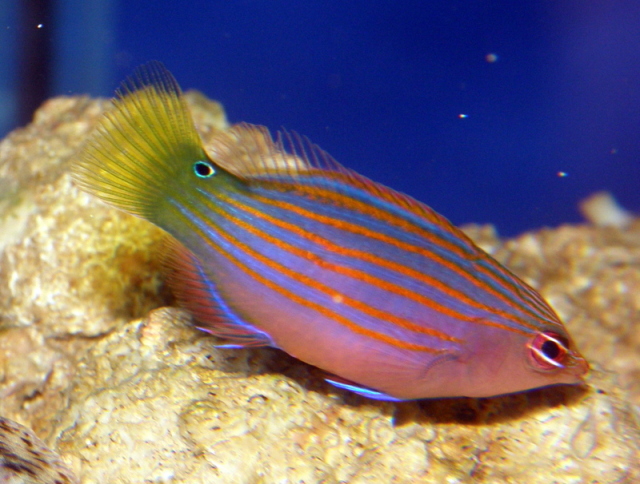 salt water Six Line Wrasse
QuestionI was just wondering if Six Line Wrasse fish ar
salt water Six Line Wrasse
QuestionI was just wondering if Six Line Wrasse fish ar
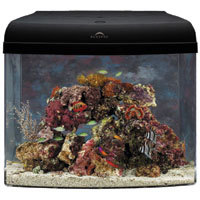 pearly jawfish
QuestionQUESTION: i just added a very small pearly jawf
pearly jawfish
QuestionQUESTION: i just added a very small pearly jawf
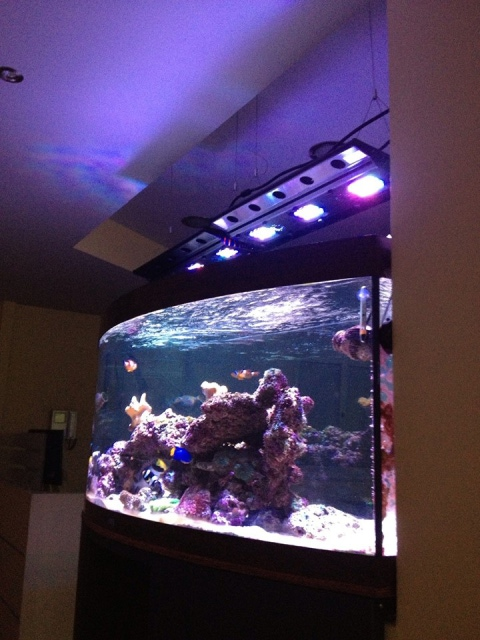 About to Buy Lights
QuestionListen, i set up a 38 gallon Aquarium, its basi
About to Buy Lights
QuestionListen, i set up a 38 gallon Aquarium, its basi
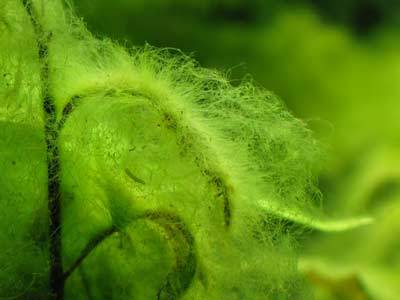 Highly disturbed, I need some HELP
QuestionHi
I have a 28 gallon saltwater tank, it has be
Highly disturbed, I need some HELP
QuestionHi
I have a 28 gallon saltwater tank, it has be
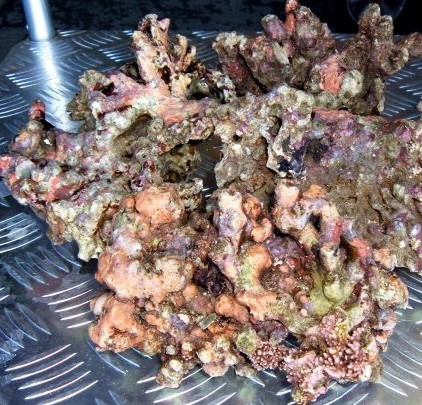 adding water
QuestionQUESTION: inherited a 30 gal tank downsized fro
adding water
QuestionQUESTION: inherited a 30 gal tank downsized fro